13-inch Retina MacBook Pro Review (Late 2012)
by Anand Lal Shimpi on November 13, 2012 2:53 AM ESTAll Flash Storage
Until NGFF gains traction in the market, SSDs with a custom physical design are going to be the norm in any system that aggressively prioritizes form factor. There has been at least some standardization within the Apple camp this past year. The 2012 iMac, Mac mini, MacBook Air and Retina MacBook Pros all use the same custom SATA+power connector on their SSDs. The standard 2012 MacBook Pro still uses a 2.5" SATA SSD as it needs to easily swap positions with a mechanical hard drive depending on what the customer orders.
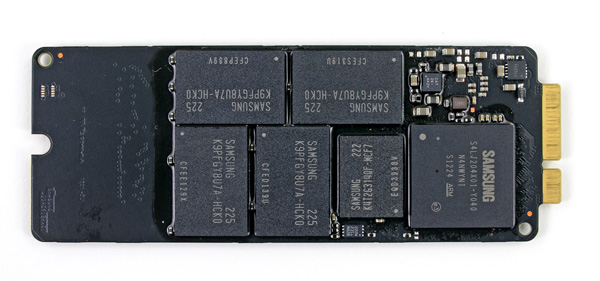
13-inch rMBP SSD module, image courtesy iFixit
The 13-inch rMBP goes one step further and uses the same physical SSD module that Apple uses in the 15-inch model. In the past Apple has used Samsung PM830 based SSDs for any drives larger than 128GB (so 256GB, 512GB and 768GB), which meant all of the 15-inch rMBPs got Samsung drives.
The 13-inch rMBP starts at 128GB however, which means there could be a chance you'll end up with a Toshiba/SandForce based solution in your Mac. Depending on your usage model (e.g. if you're going to enable FileVault), this could be undesirable. So far, all of the 128GB 13-inch rMBPs I've encountered use Samsung based drives.
As always, the easiest way to tell who makes the controller on your drive is to run a system report and look at the prefix on the drive itself: SM for Samsung and TS for Toshiba.
Performance of the PM830 based solution is quite good:
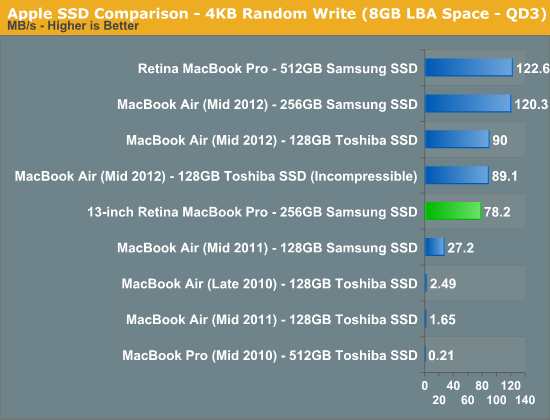

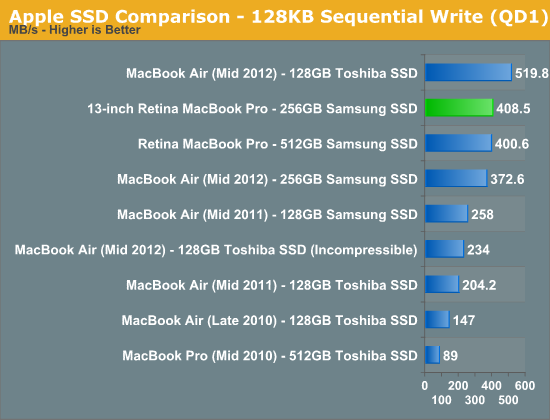
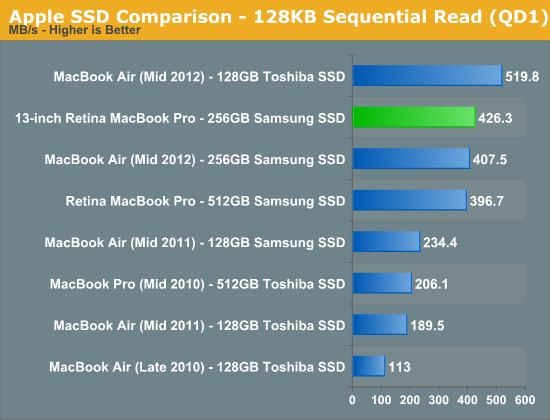
As expected, you get the same performance from the storage solution in the 13-inch rMBP as you would from the 15-inch model.
Samsung's PM830 was the controller of choice when the 15-inch rMBP hit, however now there are some interesting options available on the market. Samsung's latest MDX controller, used in the 840 Pro, will likely make its way to Apple's lineup next year. Intel's S3700 controller however provides a new optimization point for SSDs. I would love to see Apple work closely with Intel on bringing a mobile-friendly version of the S3700 to its notebooks. Although Samsung's drives have been my pick for Mac users for quite a while now, OS X doesn't respond well to unexpectedly high IO latency. As I showed in our review of Intel's SSD DC S3700, even Samsung's 840 Pro doesn't do a great job of delivering consistent random IO latency. The S3700's power profile alone will keep it out of any Apple notebooks, but there's nothing fundamentally power hungry about the controller's architecture. Apple needs the S3700 or something similar as it looks for ways to improve IO performance going forward.
Integrated SDXC Card Reader: Performance and Compatibility
The port layout remains consistent between the 13 and 15-inch rMBPs, which means that the 13-inch model retains an integrated SD card slot. The slot is mechanically different than the one used on the 15-inch model, with an inserted SD card sticking out a lot more on the 13 than it would on the 15.
SD card compatibility was measurably worse on my review sample compared to the 15-inch rMBP. I tried Patriot's EP Pro UHS-I and Patriot's LX series cards, neither of which would reliably work on the machine. I usually got disconnect errors if I even slightly moved the notebook with the EP Pro in the reader. The behavior was quite erratic. On several insertions the problematic cards worked fine, only to go back to failing regularly a few hours later. My SanDisk Ultra microSD card in a SD card adapter worked just fine on the other hand.

Performance on the reader was on-par with the 15-inch rMBP. When I could get the EP Pro working I measured around 80MB/s for reads from the card and 40MB/s when writing to the card:



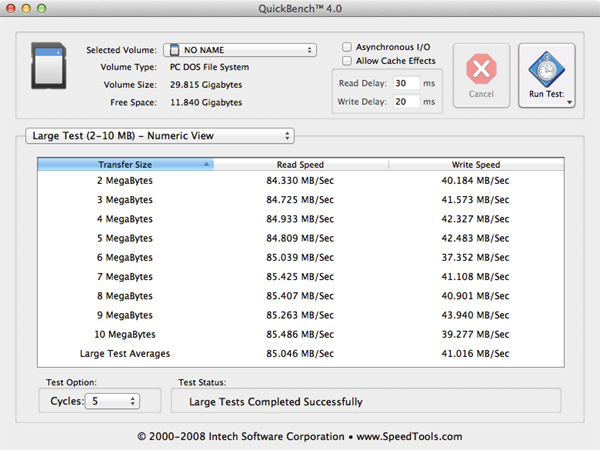








79 Comments
View All Comments
repoman27 - Tuesday, November 13, 2012 - link
And just to further clarify, Thunderbolt does not really mux DP and PCIe signals, it takes the packets from both protocols and transports them via a common switching fabric, so that wording is slightly misleading.tipoo - Tuesday, November 13, 2012 - link
In my time with these, I find there is just a bit of UI lag to most things compared to an Air or the regular Macbook Pros, most of the time it's hard to even notice unless they are side by side. The calender flip animation and sometimes the green button re-size are particularly painful, you can literally count out the frames on the former. On the 15" you can force it to use the dGPU on AC power which fixes that, but there is no fallback for the 13".tipoo - Tuesday, November 13, 2012 - link
Speaking of which, if switching to the dGPU fixes some of the lag does that mean more of the rendering pipeline is given to the Nvidia chip unlike the HD4000, as otherwise that would put a hole in the single threaded performance theory?sputnik78 - Tuesday, November 13, 2012 - link
"There's not much you can do here other than wait for faster hardware or buy the fastest CPU available on whatever system you're considering. "Yes there is. Use Firefox or Chrome.
I could not believe the depth of detail in the investigation of the scrolling in Safari issue without the simple test to swap out with Firefox or Chrome and see how much of the problem is Safari rather than the OS/Hardware.
With Firefox, you can enable and disable GPU accelerated UI as well, to see if that helps or hurts.
My experience with all three browsers is that each can have various performance issues with some websites and situations, but that when one does, one of the others tends to be OK.
MrCromulent - Tuesday, November 13, 2012 - link
Firefox doesn't even have Retina support yet, does it? Last time I heard it was planned for version 18.Disabling hardware acceleration in Firefox would probably just result in even worse performance since it is enabled by default and the CPU single-thread performance is going to get even more maxed out otherwise.
paravorheim - Tuesday, November 13, 2012 - link
Dear Anand,you mentioned in both the Intel S3700 and 13" rMBP reviews that OS X did not respond well to high IO latency. Could you expand on what you meant by that? Or is the explanation too complicated to put into layman's terms?
AmdInside - Tuesday, November 13, 2012 - link
I don't see how this is a much better option for someone who travels a lot and uses it mainly for typing. I love my MBA and only wish would be that it had more RAM and IPS display. If i had to do it all over again, I think I would still buy the MBA over the rMBP. If I had more money than I knew what to do with, I guess I'd go with the rMBP though.thefizzle656 - Tuesday, November 13, 2012 - link
IMO what is wrong with the 13" rMBP is not just that the word "Pro" doesn't at all describe the hardware specs and capabilities of the machine, but that it is so so overpriced for what you get. Even Apple Fanbois are have been criticizing Apple for the complete ripoff that the 13" rMBP is.spronkey - Tuesday, November 13, 2012 - link
You know, I have to agree with those who say there's a bit of Apple bias going on here. So many important criteria here have been glossed over - remember the pricing of this machine puts it far out of reach for most 'consumers', who go and buy $500-700 dell machines. It's a high-end part for a high-end prosumer/professional.The bottom line is - 8GB of RAM as a maximum ceiling (note - my *2008* MacBook Pro had the same limit) is far too low, and Anand you of all people should know that in the usable life of this machine (lets say 3 years), that limit is going to be hit - especially when it's not uncommon for web browsers with media-heavy content to eat 2+GB. And the move to 64-bit for stuff like the Adobe creative suite, which is a common use case for this particular machine, will eat even more RAM. I'm running 8GB on my MBP at the moment and I max it out very frequently.
I'm also not sure how you can recommend this over the 13" Air. It's much more expensive, the hardware is largley similar, performance isn't *that* much better, it doesn't offer anything in terms of upgradability other than Thunderbolt connectivity, and it's bigger and heavier. Not to mention in the real world, in 2012, it's a laggier experience.
Now, lets imagine an alternate universe where Apple decided not to shave quite so much off the size of the previous 13" pro, and instead gave us a quad core i5/i7 and a couple of RAM slots. Perhaps even a dedicated GPU and a 2.5" bay. Now that would be an improvement. What we have here is an expensive Macbook Air with a pretty display for text, that makes almost everything else look awful.
seapeople - Saturday, November 17, 2012 - link
When will we stop the insanity with this complaint about memory. Times are different, memory requirements are not going to quadruple again in the next four years. The world is not gearing up for Microsoft Gargantuan 9 which will require 8GB of RAM to load the desktop. If anything the world is going more mobile, and memory requirements will likely stagnate. Consider than an Ipad has just one GB of RAM, and they are selling about as many of those as casual consumer PC's nowadays, and you can see where we're heading.Furthermore, any browser worth its salt that's pushing 2GB of RAM based on some standard media heavy tasks will drop that RAM in an instant without a huge user experience impact if you start nearing a system limit. It's just caching everything in sight because it sees that you have 16 GB of RAM; it doesn't mean your system would grind to a halt with only 8!